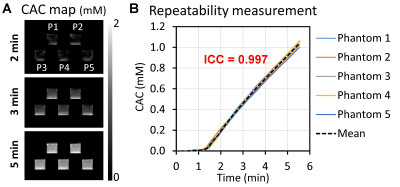Martin Dawson Holland1, Andres Morales1, Sean Simmons2, Brandon Smith1, Samuel R Misko1, Roy P Koomullil1, Junzhong Xu3, David A Hormuth, II4, Junzhong Xu3, Thomas E Yankeelov4, and Harrison Kim1
1University of Alabama at Birmingham, Birmingham, AL, United States, 2Objective Design, Birmingham, AL, United States, 3Vanderbilt University Medical Center, Nashville, TN, United States, 4University of Texas, Austin, TX, United States
1University of Alabama at Birmingham, Birmingham, AL, United States, 2Objective Design, Birmingham, AL, United States, 3Vanderbilt University Medical Center, Nashville, TN, United States, 4University of Texas, Austin, TX, United States
We developed a new disposable P4 phantom and accompanying equipment
for accurate quantitative DCE-MRI measurement in the routine clinical setting.

Fig. 1. Disposable
point-of-care portable perfusion phantom, P4. (A) Photograph and (B) 3D design of a
disposable P4 phantom. A plastic frame is used to maintain the membrane’s
flatness, and epoxy is used around the frame to prevent water leakage. The MRI
contrast agent is infused via the inlet, displacing the water in the top
chamber. The water in the top chamber is transferred to the waste chamber. The
MRI contrast agent in the top chamber diffuses to the bottom chamber through
the membrane.

Fig.
5.
Disposable
P4 repeatability. (A)
Contrast-agent concentration (CAC) maps of five disposable P4 phantoms at 2, 3
and 5 minutes after imaging initiation. The same gray scale (0-2 mM) is applied for all maps. (B) Contrast
enhancement curves (CECs) of the five phantoms together with the mean value.
The intraclass correlation coefficient (ICC) of
five CECs was 0.997.